When we think about box turtles, yellow striped colorful doomed shape comes into our minds. You may have the idea that this is the only type of box turtle which is also known as the common box turtle. But interestingly there are multiple types of box turtles available in the world.
Box turtles come in a variety of types, including ones from the U.S., Mexico, and Asia. The four most recognized species are the Common box turtle, Coahuilan box turtle, Spotted box turtle, and Ornate box turtle. However, there is more to this list. In this post, we will be talking about most of the types of box turtles we found in our research.
Table of Contents
Different Types of Box Turtles
Box turtles are a diverse group of turtles that live in a variety of environments. The North American box turtle is known for its terrestrial habitat and vibrant shell, but the Asian box turtle usually lives in subtropical areas. We have listed 13 different types of box turtles in the North American and Mexican regions. From the Asian region, we have 3 types of box turtles included here.
North American Box Turtles (Genus: Terrapene)
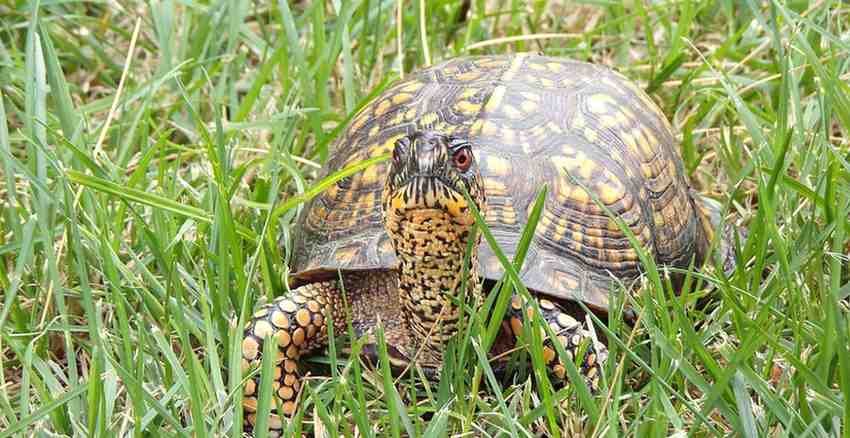
The Eastern Box Turtle is one of the most common and familiar box turtles. There are six different species of common box turtles, and the Eastern box turtle is one of them. It is a well-known species native to the eastern United States. They are often found in wooded areas or mixed forests as terrestrial species. They’re known for their yellow color on dark brown distinctive hinged shells.
- Common Name: Eastern Box Turtle
- Family: Emydidae
- Genus: Terrapene
- Scientific Name: Terrapene carolina carolina
- Size: 4.5 to 6 inches
- Lifespan: 30 to 40 years
- Male/Female Differences: Males often have brighter colors and a concave plastron.
- Habitat: Deciduous or mixed forest regions
- Patterns: Bright yellow to orange patterns on a dark brown shell
- Type: Tortoise
- Diet: Mainly omnivores
- Best for: Intermediate pet owners
- Where they are found:
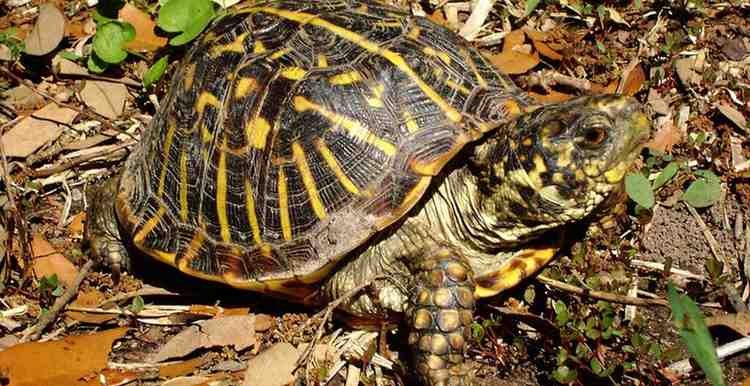
The ornamental box Turtle is known for its unique starburst pattern on the shell. It is native to the grasslands of the Great Plains. Like eastern box turtles, ornamental box turtle shell patterns and colors are attractive. They have yellow-striped patterns on dark brown shells. This turtle species is quite suitable for keeping as pets.
- Common Name: Ornate Box Turtle
- Family: Emydidae
- Genus: Terrapene
- Scientific Name: Terrapene ornata ornata
- Size: 4 to 5 inches
- Lifespan: 30 to 40 years
- Male/Female Differences: Males generally exhibit brighter patterns and possess red eyes.
- Habitat: Grasslands of the Great Plains
- Patterns: Distinctive starburst pattern on a dark shell
- Type: Tortoise
- Best for: Experienced pet owners
- Where they are found: Wisconsin, Oklahoma Arizona, , Texas, Colorado, Louisiana, Illinois, Iowa, Kansas, Arkansas, Missouri, Wyoming, Indiana Nebraska, New Mexico, South Dakota
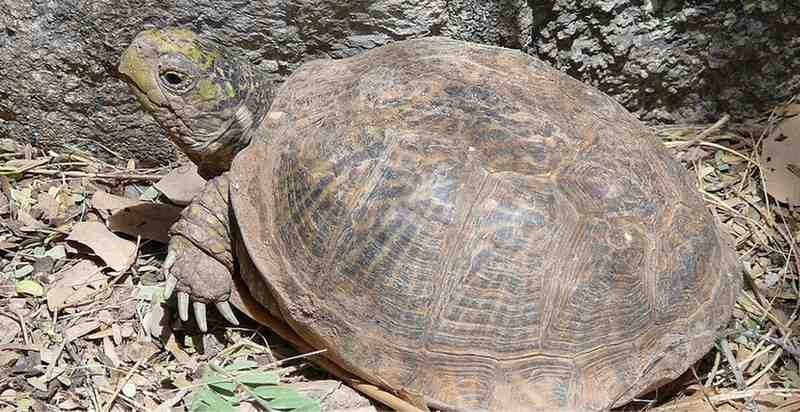
Desert box turtles are semi-aquatic turtles mainly found in the southwestern region of the US and the northern side of Mexico. Although they are semi-aquatic, they mostly live on the surface. Desert turtle’s shell color is brown to reddish brown and has lighter patterns than ornate box turtles. They are mainly omnivores, besides this, they eat insects, crickets, and worms from their surroundings. Their desert habitats require them to stay hydrated and withstand high temperatures.
- Common Name: Desert Box Turtle
- Family: Emydidae
- Genus: Terrapene
- Scientific Name: Terrapene ornata luteola
- Size: 4 to 6 inches
- Lifespan: 30 to 40 years
- Male/Female Differences: Males typically have a longer tail and brighter coloration.
- Habitat: Arid environments in the Southwestern U.S., including deserts and scrublands
- Patterns: Subtle, muted patterns with a light brown or tan shell
- Type: Tortoise
- Best for: Experienced pet owners who can recreate dry, warm conditions
- Where they are found: Arizona, New Mexico, Texas
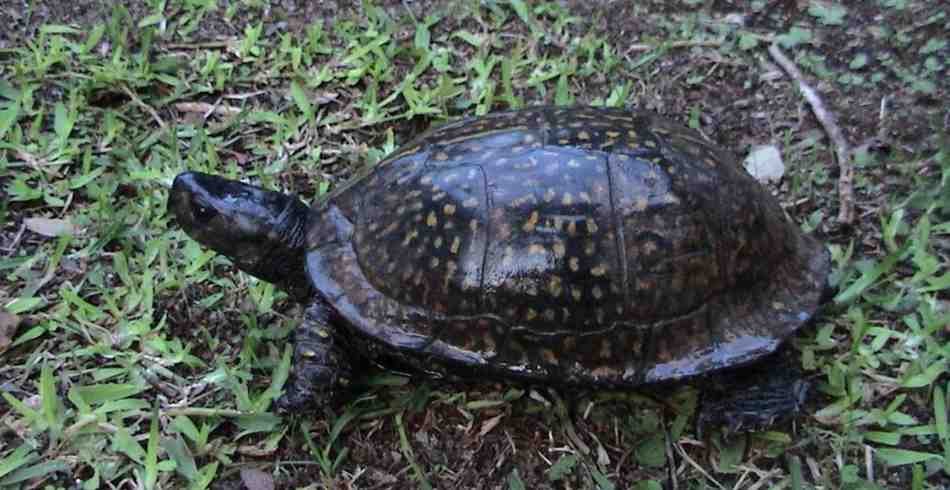
Gulf Coast box turtles are also semi-aquatic and their size is the largest among all common box turtle species. This turtle’s length can grow up to 8 inches or 20 cm in shell length. They’re mostly found in Florida, and Louisiana along the Mexican Gulf Coast, where their habitat is moist and forested. In general, their shell color is dark brown or black, with yellow stripes or dots. The Gulf Coast box turtle can be found along the Gulf of Mexico from the state of Louisiana to the state of Florida.
- Common Name: Gulf Coast Box Turtle
- Family: Emydidae
- Genus: Terrapene
- Scientific Name: Terrapene carolina major
- Size: 5 to 7 inches
- Lifespan: 30 to 50 years
- Male/Female Differences: Males often have a concave plastron and brighter coloration.
- Habitat: Humid coastal regions, including swamps and marshes
- Patterns: Dark, often with yellow or orange markings; patterns can vary greatly
- Type: Tortoise
- Best for: Experienced pet owners or conservationists focused on wetland habitats
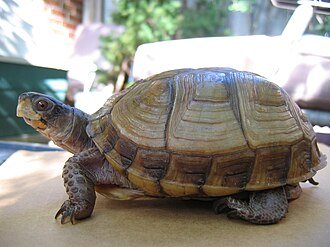
The three-toed box turtle (Terrapene triunguis) comes from the south-central United States and it is Missouri’s official reptile. The Three-toed Box Turtle is easily recognized by its unique three-toed hind feet. These species are considered to as a subspecies of the eastern box turtle.
They are named for having three toes on their back feet, although some of them may have four toes. Their domed shell grows about 5 to 7 inches long.
- Common Name: Three-toed Box Turtle
- Family: Emydidae
- Genus: Terrapene
- Scientific Name: Terrapene carolina triunguis
- Size: 4 to 6 inches
- Lifespan: 30 to 50 years
- Male/Female Differences: Males typically have red or orange eyes and a concave plastron.
- Habitat: Central United States, including forests, grasslands, and areas near water bodies
- Patterns: Typically olive or brown with faint yellow or orange spots; patterns can vary
- Type: Tortoise
- Best for: Intermediate pet owners who can provide a balanced habitat
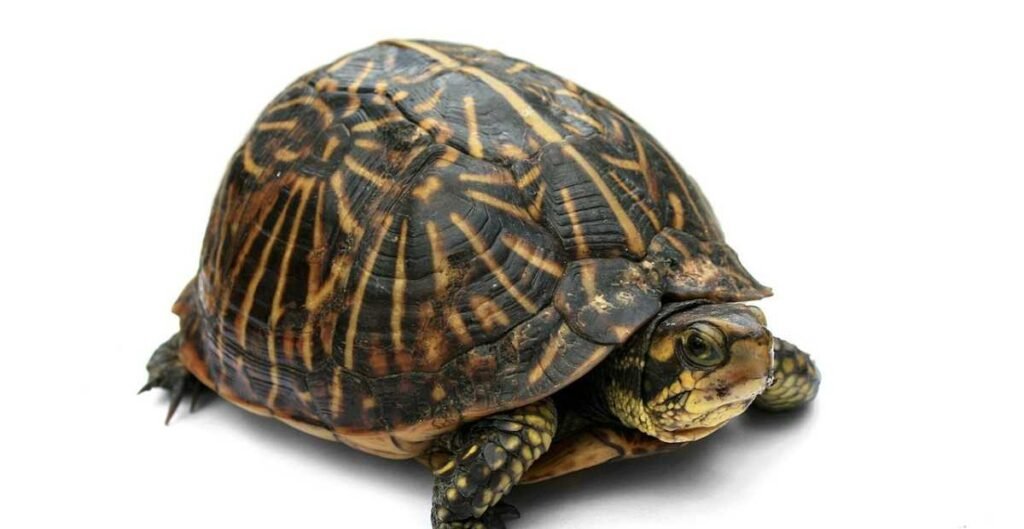
The Florida box turtle (Terrapene carolina bauri) is a type of box turtle found in Florida and southeastern Georgia. It is one of six living subspecies of the common box turtle and they are mostly found in the southern range. Its shell has unique yellow stripes on the dark brown shell, and this attractive look makes it easy to recognize. The bottom of its shell can be all yellow, all black, or a mix of both.
- Common Name: Florida Box Turtle
- Family: Emydidae
- Genus: Terrapene
- Scientific Name: Terrapene carolina bauri
- Size: 4 to 6 inches
- Lifespan: 30 to 50 years
- Male/Female Differences: Males usually have red eyes and a longer tail, while females have brown eyes and a shorter tail.
- Habitat: Wetlands and forests in Florida, often found near swamps and marshes
- Patterns: Highly variable; typically features bright yellow or orange markings on a dark shell
- Type: Tortoise
- Best for: Enthusiasts who can accommodate their need for humid environments
- Yucatán Box Turtle (Terrapene carolina yucatana)

The Yucatán box turtle (Terrapene yucatana) is a turtle species found only in Mexico. It is sometimes considered a subspecies of the Terrapene Carolina. Its shell is light-colored with unique star-shaped dark spots, which give it a distinct look.
- Common Name: Yucatán Box Turtle
- Family: Emydidae
- Genus: Terrapene
- Scientific Name: Terrapene carolina yucatana
- Size: 5 to 7 inches
- Lifespan: 30 to 50 years
- Male/Female Differences: Males typically have longer, thicker tails and brighter eye coloration, while females have shorter tails and more subdued eye colors.
- Habitat: Native to the Yucatán Peninsula, inhabiting tropical forests and areas with dense foliage
- Patterns: Exhibits unique coloration with contrasting patterns that help in camouflage within its lush habitat
- Type: Tortoise
- Best for: Individuals interested in tropical ecosystems and conservation efforts, who can provide a habitat that mimics the turtle’s natural environment
- Northern Box Turtle (Terrapene nelsoni klauberi)
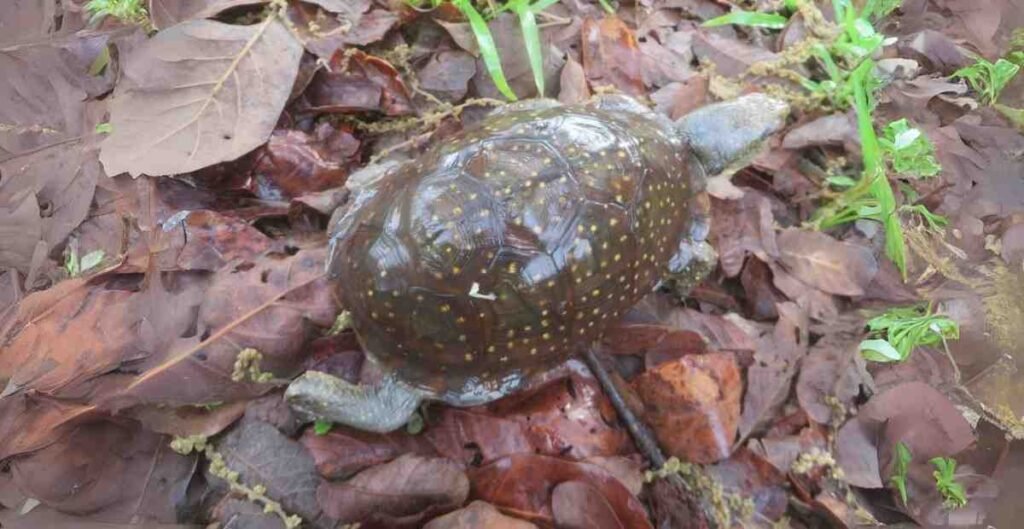
The northern spotted box turtle (Terrapene nelsoni klauberi) is a type of turtle in the Emydidae family. It lives in the Sierra Madre Occidental mountains. This turtle is also called Klauber’s box turtle or Klauber’s spotted box turtle. It’s a subspecies of the spotted box turtle and goes by several other names. However, it is mostly known as the northern spotted box turtle.
- Common Name: Northern Box Turtle
- Family: Emydidae
- Genus: Terrapene
- Scientific Name: Terrapene nelsoni klauberi
- Size: Typically 5 to 7 inches
- Lifespan: 30 to 50 years
- Male/Female Differences: Males usually exhibit more vibrant spotting and longer tails, while females have subtler patterns and shorter tails.
- Habitat: Prefers dry, semi-arid regions with a mix of vegetation, often found in scrublands and lightly forested areas
- Patterns: Features distinctive spotting, similar to its parent species, with spots creating an effective camouflage against the natural backdrop
- Type: Land turtle
- Best for: Individuals interested in studying species with specialized habitats and contributing to preservation initiatives
- Spotted Box Turtle (Terrapene nelsoni)
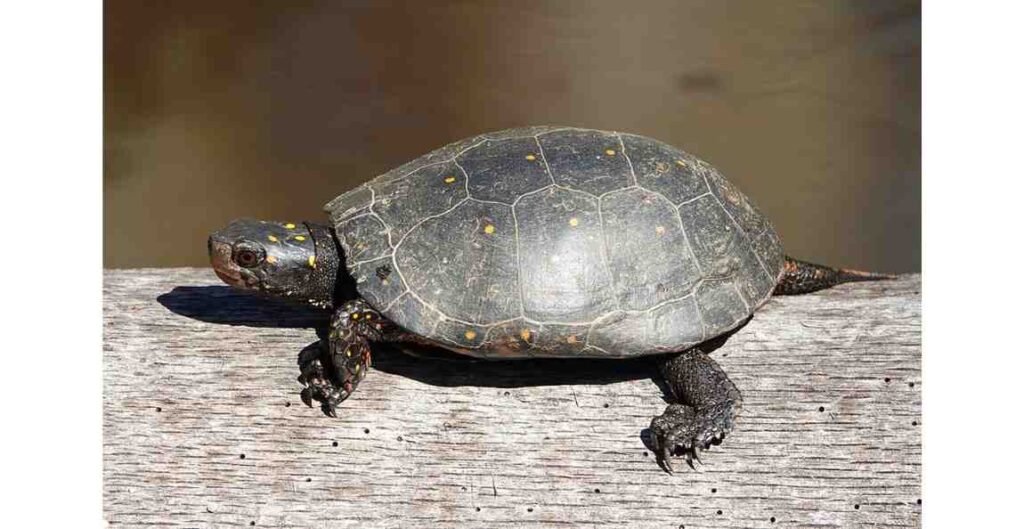
The spotted box turtle (Terrapene nelsoni) is only found in the Sierra Madre Occidental in Mexico. These turtles have small light yellow spots on their dark brown shells. There are two recognized subspecies of spotted box turtles. One is the northern spotted box turtle (Terrapene nelsoni Flaubert), and the southern spotted box turtle (Terrapene nelsoni nelsoni).
- Common Name: Spotted Box Turtle
- Family: Emydidae
- Genus: Terrapene
- Scientific Name: Terrapene nelsoni
- Size: 5 to 7 inches
- Lifespan: 30 to 50 years
- Male/Female Differences: Males often have brighter, more vibrant spotting and longer tails, while females typically have more muted spots and shorter tails.
- Habitat: Prefers dry, semi-arid regions with plenty of vegetation, often found in scrublands and light forests within its limited range
- Patterns: Characterized by numerous small, bright spots scattered across its dark shell, providing effective camouflage in dappled sunlight
- Type: Land turtle
- Best for: Those interested in species with limited geographic distribution and efforts toward habitat preservation
- Coahuilan Box Turtle (Terrapene coahuila)
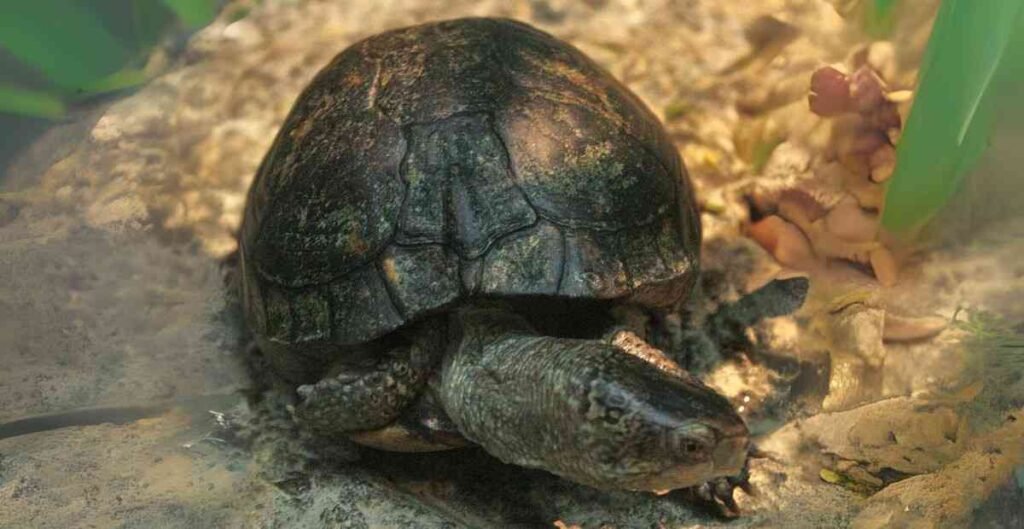
The Coahuilan box turtle (Terrapene coahuila) is also called the aquatic box turtle. It is an endangered species in the Emydidae family. Unlike other box turtles, it spends about 90% of its time in the water. Like other box turtles, it has a hinged plastron that can close completely. The turtle’s skin is usually dark brown or grey, with a yellow-colored ring shape. It’s closely related to the common box turtle.
- Common Name: Coahuilan Box Turtle
- Family: Emydidae
- Genus: Terrapene
- Scientific Name: Terrapene coahuila
- Size: 6 to 8 inches
- Lifespan: 20 to 30 years
- Male/Female Differences: Males generally have longer tails and a slightly concave plastron, while females have shorter tails and a flatter plastron.
- Habitat: Prefers aquatic environments, such as ponds and marshes, in the Cuatro Ciénegas region of Coahuila, Mexico
- Patterns: Exhibits a dark shell with subtle, muted patterns that provide camouflage in muddy waters
- Type: Aquatic turtle
- Best for: Conservationists and researchers focused on wetland preservation and species recovery efforts
- Southern Box Turtle (Terrapene nelsoni nelsoni)
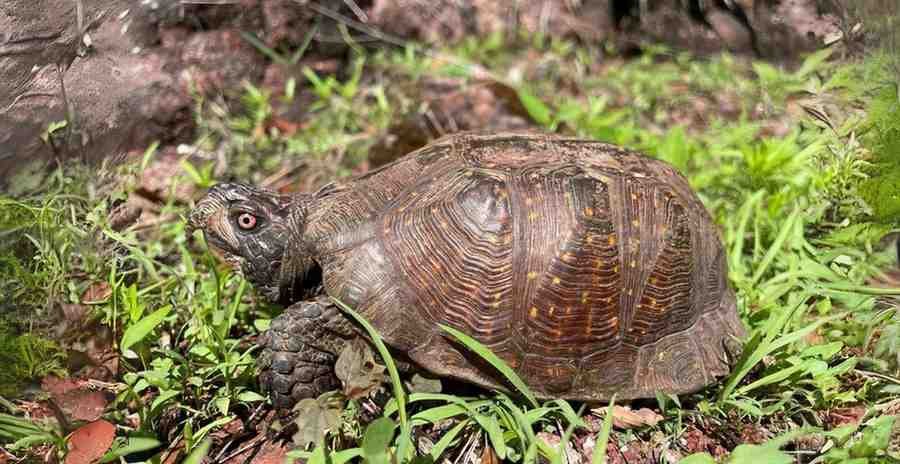
The southern spotted box turtle (Terrapene nelsoni nelsoni) is a type of turtle in the Emydidae family. It lives only in the Sierra Madre Occidental in Mexico. Sometimes called the southern box turtle, it is mainly found in the southern part of the spotted box turtle’s range.
- Common Name: Southern Box Turtle
- Family: Emydidae
- Genus: Terrapene
- Scientific Name: Terrapene nelsoni nelsoni
- Size: Typically 5 to 7 inches
- Lifespan: 30 to 50 years
- Male/Female Differences: Males often have more pronounced and vibrant patterns with longer tails, while females display subtler markings and shorter tails.
- Habitat: Inhabits dry, semi-arid regions with plenty of vegetation, frequently found in scrublands and light forest areas
- Patterns: Exhibits distinctive spots and patterns that provide excellent camouflage against the natural backdrop of its environment
- Type: Land turtle
- Best for: Those who want to study species with specialized habitats and support local conservation.
- Mexican Box Turtle (Terrapene carolina Mexicana)
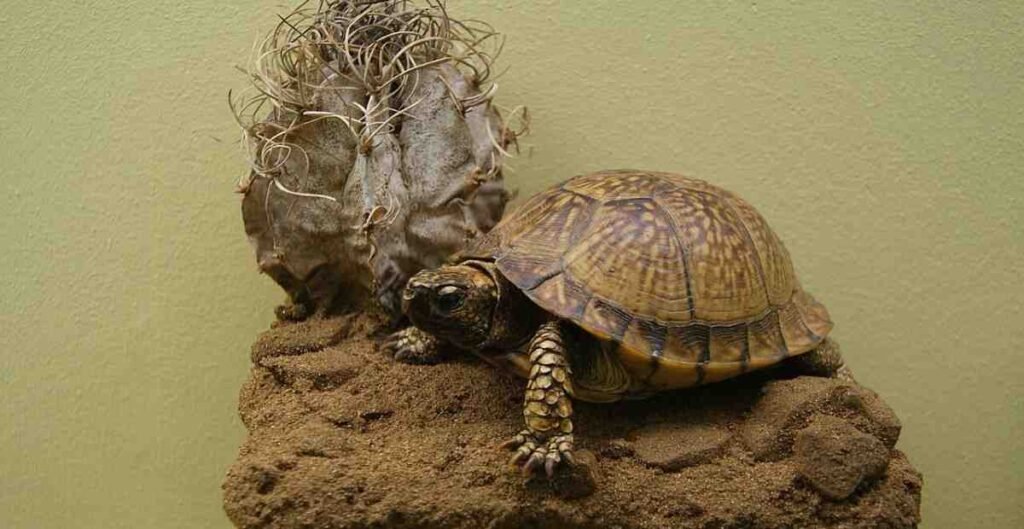
The Mexican box turtle (Terrapene mexicana) is a box turtle species found in Mexico, hence the name. This turtle can grow to about 18–20 cm long. Its shell is dome-shaped, with yellow coloring and varied markings. It is sometimes considered a subspecies of Terrapene carolina and they can also be found in Tamaulipas, Veracruz, and San Luis Potosi, Mexico.
- Common Name: Mexican Box Turtle
- Family: Emydidae
- Genus: Terrapene
- Scientific Name: Terrapene carolina mexicana
- Size: 4 to 7 inches
- Lifespan: 30 to 50 years
- Male/Female Differences: Males typically have a concave plastron and longer, thicker tails, while females have flatter plastrons and shorter tails.
- Habitat: Prefers tropical and subtropical forests, often found in moist environments with plenty of cover
- Patterns: Shell patterns are highly variable, often featuring elaborate combinations of dark and light colors that provide excellent camouflage
- Type: Tortoise
- Best for: Experienced turtle keepers who appreciate their complex environmental needs and can provide suitable habitats
Asian Box Turtles (Genus: Cuora)
Asian Box Turtles are another group of turtles that thrive outside the United States, particularly in Asia.
- Chinese Box Turtle (Cuora flavomarginata)
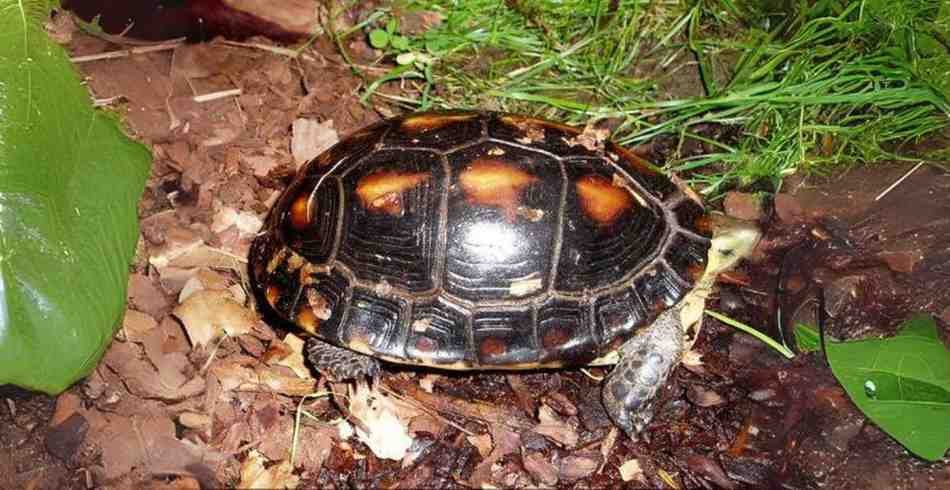
The Chinese box turtle is an Asian turtle that is also known as the yellow-margined or golden-headed turtle. This turtle has a brown, domed shell with a yellow stripe on its back. The top of its head is pale green, and the skin on its limbs is brown. Male turtles have broader, almost triangular tails compared to females.
- Common Name: Chinese Box Turtle
- Family: Geoemydidae
- Genus: Cuora
- Scientific Name: Cuora flavomarginata
- Size: Typically 6 to 8 inches
- Lifespan: 50 to 70 years
- Male/Female Differences: Males usually have concave plastrons and longer, thicker tails, while females tend to have flatter plastrons and shorter tails.
- Habitat: Prefers warm, moist environments such as subtropical forests and riverbanks, often found near water sources
- Patterns: Characterized by its dark brown to black shell with distinctive yellow margins, offering both camouflage and a striking appearance
- Type: Semi-aquatic turtle
- Best for: Individuals interested in species in subtropical ecosystems
- Malayan/Amboina Box Turtle (Cuora amboinensis)
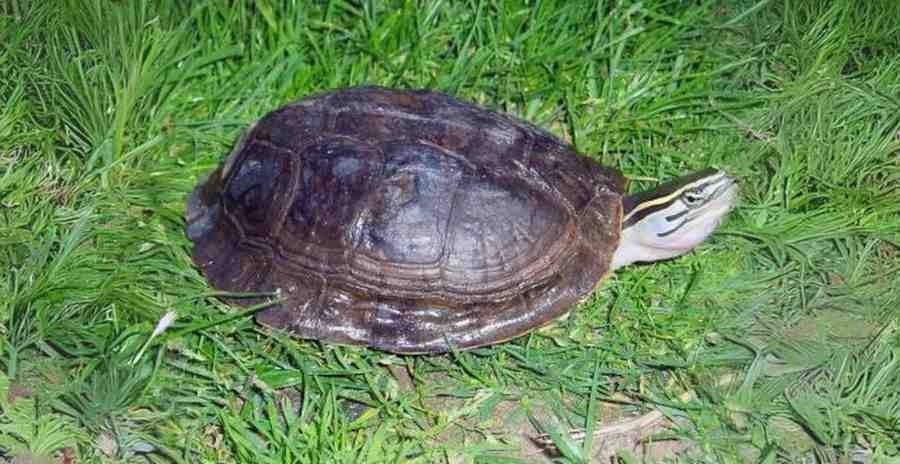
The Amboina box turtle is also known as the Southeast Asian box turtle (Cuora amboinensis). This turtle species is found in Southeast Asia. Its name comes from Ambon Island in Indonesia. These turtles have dark brown to olive shells, which are simpler than other box turtles. They have a blackish olive head with three yellow stripes on each side. The size of this turtle varies by subspecies and sex, but they’re usually between 200 and 250mm.
- Common Name: Malayan Box Turtle
- Family: Geoemydidae
- Genus: Cuora
- Scientific Name: Cuora amboinensis
- Size: Typically 7 to 9 inches
- Lifespan: 30 to 50 years
- Male/Female Differences: Males often have longer, thicker tails and more concave plastrons, while females tend to have flatter plastrons.
- Habitat: Favors freshwater environments such as marshes, swamps, and slow-moving streams in humid, tropical climates
- Patterns: Dark brown to black shell with subtle yellow or orange stripes running along the head and limbs
- Type: Semi-aquatic turtle
- Best for: Those interested in studying adaptable species and ecosystems in Southeast Asia
- McCord’s Box Turtle (Cuora mccordi)
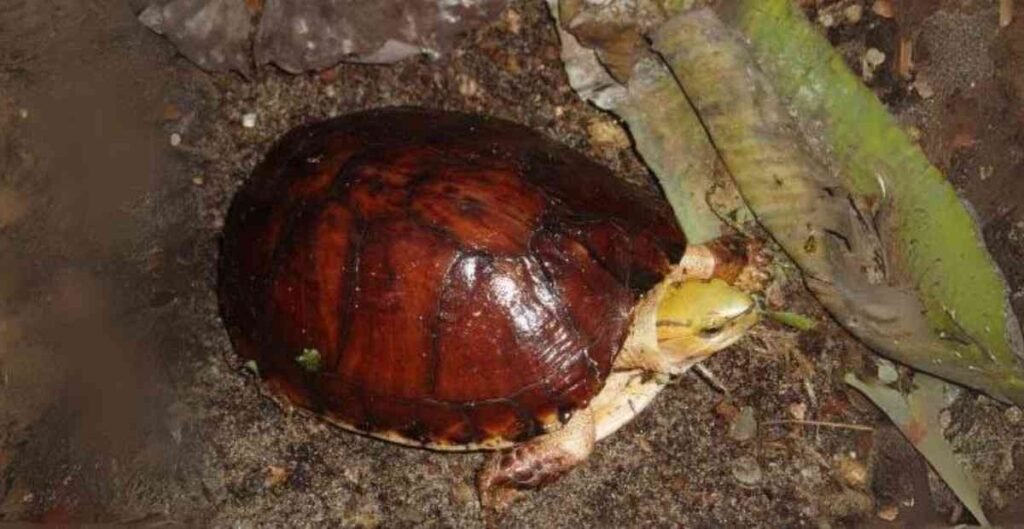
McCord’s box turtle (Cuora mccordi) is a turtle native to China. They can grow only up to 14 cm (5.5 in), but some can now reach 18 cm (7.1 in). This turtle lives only in central Guangxi province. It is one of the most endangered turtles in China because these turtles are sought after for traditional medicine and by collectors.
- Common Name: McCord’s Box Turtle
- Family: Geoemydidae
- Genus: Cuora
- Scientific Name: Cuora mccordi
- Size: Typically 5 to 7 inches
- Lifespan: Estimated to be 30 to 40 years
- Male/Female Differences: Males generally have longer tails and more vivid shell patterns, while females have shorter tails and less pronounced patterns.
- Habitat: Inhabits forested areas with access to freshwater sources in subtropical regions
- Patterns: Notable for its pale shell with intricate black lines and a striking yellowish head
- Type: Terrestrial turtle
- Best for: Conservationists focused on protecting endangered species and those involved in anti-poaching initiatives
Wrapping Up
So, here our list ends for different types of box turtles. All of these box turtle species have something unique considering their physical structure, habitat and so on. If you didn’t know there are a variety of box turtle species or looking for different types of box turtle species – we hope this information here will fulfill your query.
FAQs
How many types of box turtles are there?
There are many kinds and subspecies of box turtles. Box turtle comes in four different types: the Common Box Turtle, the Coahuilan Box Turtle, the Spotted Box Turtle, and the Ornate Box Turtle. Every Box turtles species are very different because each species has several types. The Eastern Box Turtle, the Three-toed Box Turtle, and the Gulf Coast Box Turtle are all subspecies of the Common Box Turtle. Box turtles’ significant feature is that – they have hinged shells so they can close up tight for safety.
What are the different types of box turtles?
There are various types of box turtles. Each type has distinct characteristics and lives in different environments. Eastern Box Turtles are common in wooded regions in the east, and Ornate Box Turtles are found in grasslands and have beautiful shell patterns. The Three-toed Box Turtle is another variety, primarily found in damp, wooded areas. Every type of box turtle has adapted to grow in its unique surroundings, ranging from arid deserts to lush wetlands.
What type of box turtle do I have?
Identifying tortoise species like box turtles’ unique traits of your box turtle can be thrilling, To identify the type, notice its shell pattern, color, and physical characteristics. For example, Eastern Box Turtles feature vibrant markings on their high-domed shells. Whereas the Three-toed Box Turtle usually has a simple brown shell and has three toes on its hind feet. If your turtle shows a preference for dry, open spaces, it is most likely to be an Ornate Box Turtle. You can identify your turtle’s species by talking to a reptile specialist or reading a comprehensive guide.
What type of food do box turtles eat?
Box turtles eat both plants and animals, which means they have a diverse diet. They usually consume fruits, vegetables, insects, and occasionally small animals. A well-rounded diet for a box turtle could consist of berries, leafy greens, worms, and mushrooms. Offering a diverse range of foods is essential to guarantee they obtain all the vital nutrients they need.
Can different types of box turtles mate?
Different types of box turtles may occasionally mate, particularly when they are closely related subspecies. Successful mating and the production of viable offspring rely on compatibility, which can differ. It is usually not advisable to breed box turtles of different types, as this can lead to hybrid offspring that may not thrive as effectively as their genetic relatives. Focusing on the preservation of the natural diversity within each subspecies is essential.
